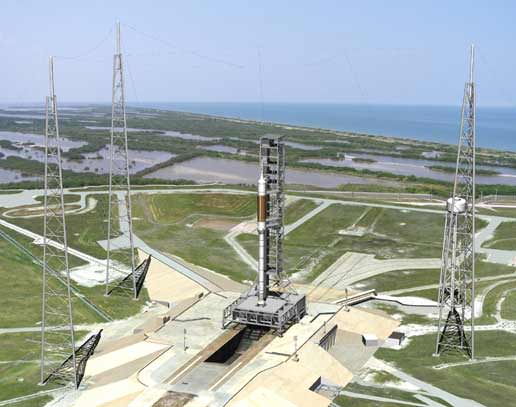[/caption]
Things are a-changing over at the Kennedy Space Center launch complex. The first lightning tower for the Ares rockets has been completed, dwarfing all the other structures on pad 39B. The tower is for the new lightning protection system for the Constellation Program. Other towers are being constructed at left and behind the service structures on the pad. Each of the three new lightning towers will be 152 meters (500 feet) tall with an additional 30 meter (100-foot) fiberglass mast atop supporting a catenary, or overhead wire system. This compares to the height of the shuttle Fixed Service Structure at 105.7 meters (347ft) to the top of the lightning mast. The new and improved lightning protection system allows for the taller height of the Ares I rocket compared to the space shuttle. Pad 39B will be the site of the first Ares vehicle launch, including the Ares I-X test flight that is targeted for July 2009. See image below for what the completed system will look like.

This is an artist’s rendition of what the new lightning protection system being built at Launch Pad 39B will look like when fully completed. The launch pad will also be modified to support future launches of Ares and Orion spacecraft.
8 Replies to “New Ares Construction “Towers” Over 39B”
Comments are closed.


I wonder why they did not have something like this during the Apollo days? The Saturn 5 was 363 feet tall and it was struck by lightning during the Apollo 12 launch in 1969.
Live and learn!
I still wonder why we need to build something like this. Ares’ future is not sure, in my opinion the stick design is flawed in its roots and actually there may be a transition to existing rockets like Ares V and Delta IV.
Which is the best decision, because these rockets are already built.
Perhaps NASA, nor anyone else, understood lightning well enough to design an effect lightning protection/suppression system.
Lightning rods as a way to draw lightning away from structures and send it into the ground were well known in the 1960s, along with the fact that the taller you are (and especially if you are made of metal), the better your chances of being zapped. And if you are full of explosive fuel, even moreso.
Huygens wrote:
“I wonder why they did not have something like this during the Apollo days? The Saturn 5 was 363 feet tall and it was struck by lightning during the Apollo 12 launch in 1969.”
Further, according to Wiki (http://en.wikipedia.org/wiki/Apollo_12), the lightening strike occurred *36.5 seconds* after launch. Altitude at that moment isn’t mentioned, but I’m quite sure no technology of the day was available to build towers of ANY sort as high as the craft was at that moment (nanotech theoretically COULD be used to build such towers, but I’m guessing that will never occur).
Ares is inherently more susceptible to a catastrophic failure due to lightning as it uses pre-mixed fuel, unlike Apollo. Similarly if lightning somehow induced an early ignition signal, Ares cannot be shut down.
The towers are needed due to the nature of propellant.
I wonder if the towers will double up as camera platforms, to film the launches..